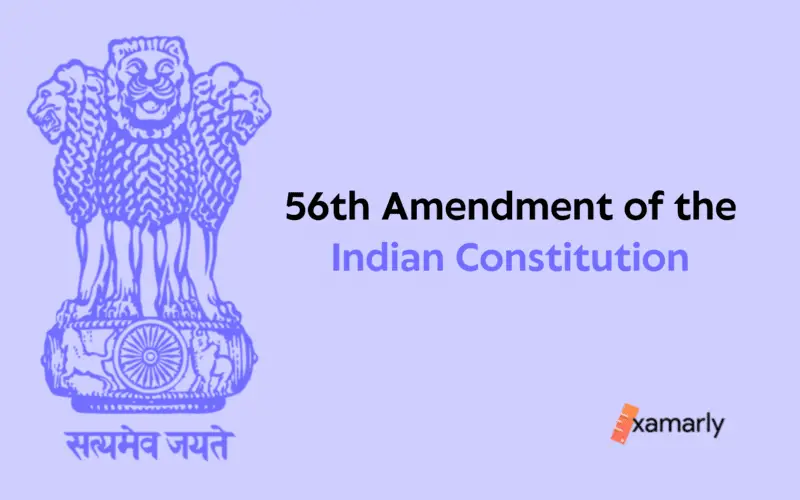

The 56th Amendment of the Indian Constitution is also known as The Constitution (Fifty-sixth Amendment) Act, 1987. It granted Statehood to Goa.
The date of enactment, its salient facts and features, the Statement of Objects and Reasons, the prominent people involved, and its important provisions have been summarized in the following lines.
Read on to know more about the Fifty-sixth Amendment Act of the Constitution of India.
Table Of ContentsThe region of Goa has had about 450 years of struggle with the Portuguese. This ended in 1961 with the acquisition of control over Goa, Daman and Diu from the Portuguese.
Further, The Constitution (Twelfth Amendment) Act, 1962, revised the First Schedule to the Constitution. Under this Act, Goa, Daman and Diu became the eighth Union territory of India.
The Fifty-sixth Amendment Act helped in changing the status of Goa from a Union territory to a full-fledged state. It acquired a special status.
Its rich background has laid a solid foundation for helping Goa in flourishing as an independent state. This development benefitted not only Goa but the entire country.
The State of Goa was initially a part of the Union Territory of Goa, Daman, and Diu until the Fifty-sixth Amendment Act was enforced.
It acquired its independent identity as a state after the Amendment Act was executed.
The Fifty-sixth Amendment Act of the Indian Constitution was enforced on May 23rd, 1987.
The 56th amendment of the Indian constitution was passed in the thirty-eighth year of the Republic of India. It was enacted by the Parliament.
An important feature of this amendment was the introduction of Article 371-I into the Constitution of India.
This article was to be added after Article 371H. Goa attained a new identity as a state of the Union of India.
On the other hand, a separate Union territory of Daman and Diu also came into existence.
The Constitution (Fifty-seventh Amendment) Bill, 1987 is accompanied by a Statement of Objects and Reasons.
This document dated May 6th, 1987 states the purpose for making the changes. These have been summarized in the lines below.
The bill was later enacted and came to be known as The Constitution (Fifty-sixth Amendment) Act, 1987.
As per a proposal by the Government of India, the State of Goa will constitute those territories that fall under the Goa district of the Union territory of Goa, Daman and Diu.
The new Union territory of Daman and Diu will include all those territories in that Union territory that comprise its Daman and Diu districts.
Keeping this in view, it is further proposed to have a specific number of members in the Legislative Assembly of the new State of Goa.
This number is forty. The Legislative Assembly of the Union territory must comprise both elected as well as nominated members for Goa, Daman and Diu.
Thirty are elected members whereas three are nominated members. This Assembly is to become the provisional Legislative Assembly for the new State of Goa.
However, two members who represent Daman and Diu districts are to be excluded from this Assembly. The provisional Legislative Assembly will be valid for up to a five-year term.
On the expiry of the five-year term of the existing Assembly, elections are to be held. Therefore, it is proposed to provide that there must be a minimum of thirty members in the Legislative Assembly. This applies to the new State of Goa.
The above-mentioned proposals can come into effect by making special provisions in the Constitution.
The modification of the Constitution is intended by the Bill following the proposal. A separate Bill is also being introduced for the formation of the new State of Goa.
This is done with the purpose of re-organization of the current Union territory of Goa, Daman and Diu.
The Statement of Objects and Reasons was included in the Constitution (Fifty-seventh Amendment) Bill, 1987. It was framed by Buta Singh. The Bill was approved by Zail Singh who held the position of President that year.
This amendment renders authority to the Central Government to appoint the date on which the act shall come into force. This can be done by issuing a notification in the Official Gazette.
An important feature of the 56th Constitutional Amendment of India was the introduction of Article 371-I. Special provision was held in this article.
Special provision with respect to the statehood status of Goa is mentioned in this article. Despite anything in the Constitution, according to Article 371-I, the State of Goa must have a minimum of forty members in its Legislative Assembly.
Amendments to the Indian Constitution have an indispensable contribution to providing Statehood to several Union territories.
The Constitution (fifty-sixth Amendment) Act, 1987 along with the introduction of Article371-I played a crucial role in assigning statehood identity to Goa.
It helped the place become one of India’s most resided-in states and the most visited tourist attractions on a global level. As an independent state, personal growth, education, and tourism were emphasized as part of developmental projects.
Konkani language was promoted. There was a gradual increase in the population. The Fifty-sixth Amendment Act also allowed Daman and Diu to attain the status of the separate Union territory of the Union of India.
After the enforcement of The Constitution (Fifty-sixth Amendment) Act, 1987, Goa attained the constitutional status of a distinct state. A new Union Territory of Daman and Diu was also established.
After the Fifty-sixth Amendment Act of the Indian Constitution, Goa became the twenty-fifth state of the Indian Republic in the year 1987.
Goa attained the status of Statehood after The Constitution (Fifty-sixth Amendment) Act, 1987. Before this, it was recognized as a Union territory.
Goa became a state of India on May 30, 1987.
The official language of Goa is Konkani, but Marathi and English are also widely spoken.